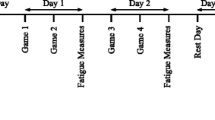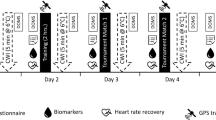Abstract
The aim of this study was to determine the effects of a simulated one-day Greco-Roman wrestling tournament on selected performance and inflammatory status indices. Twelve competitive wrestlers (22.1 ± 1.3 years) completed five matches according to the official Olympic wrestling tournament regulations following a ~6% weight loss. Performance measurements, muscle damage assessment, and blood sampling were performed before and following each match. Performance and inflammatory markers were not affected by weight loss. Mean wrestling heart rate reached ~85% of maximal and lactate concentration exceeded 17 mM. Fatigue rating demonstrated a progressive rise (P < 0.05) throughout the tournament, peaking in match 4. Performance demonstrated a progressive deterioration (P < 0.05) throughout the tournament, especially in the last two matches (P < 0.05), with upper-body measures exhibiting a greater decline (P < 0.05) and remaining below baseline (P < 0.05) until the end of the tournament. Muscle damage markers increased during the course of the tournament with upper limbs affected more. Creatine kinase activity, CRP levels, IL-6 concentration, and leukocyte counts increased (P < 0.05) progressively throughout the tournament, peaking in the last two matches. Cortisol, epinephrine and norepinephrine increased (P < 0.05) after each match, but testosterone declined (P < 0.05) progressively, reaching a nadir before the last match. This inflammatory response was accompanied by a marked increase (p < 0.05) in lipid peroxidation, protein oxidation, and antioxidant status markers indicating the development of oxidative stress. These results suggest that a one-day wrestling tournament may induce significant physiological demands on wrestlers that may adversely affect their performance and inflammatory status especially during the later stages of the tournament.




Similar content being viewed by others
References
American College of Sports Medicine (1996) American College of Sports Medicine position stand on weight loss in wrestlers. Med Sci Sports Exerc 28:9–12
Aoi W, Naito Y, Takanami Y, Sakuma K, Ichikawa H, Yoshida N, Yoshikawa T (2004) Oxidative stress and delayed onset muscle damage after exercise. Free Rad Biol Med 37:480–487
Armstrong RB, Oglivie RW, Schwane JA (1983) Eccentric exercise-induced injury to rat skeletal muscle. J Appl Physiol 54:80–93
Artioli GG, Iglesias RT, Franchini E, Gualano B, Kashiwagura DB, Solis MY, Benatti FB, Fuchs M, Lancha AH (2010) Rapid weight loss followed by recovery time does not affect judo-related performance. J Sports Sci 28:21–32
Aschenbach W, Ocel J, Craft L, Ward C, Spangenburg E, Williams J (2000) Effect of oral sodium loading on high-intensity arm ergometry in college wrestlers. Med Sci Sports Exerc 32:669–675
Balakrishnan SD, Anuradha CV (1998) Exercise, depletion of antioxidants and antioxidant: manipulation. Cell Biochem Funct 16:269–327
Batistaki C, Kostopanagiotou G, Myrianthefs P, Dimas C, Matsota P, Pandazi A, Baltopoulos G (2008) Effect of exogenous catecholamines on tumor necrosis factor alpha, interleukin-6, interleukin-10 and beta-endorphin levels following severe trauma. Vasc Pharmacol 48:85–91
Callan SD, Brunner DM, Devolve KL, Mulligan SE, Hesson J, Wilber RL, Kearney JT (2000) Physiological profiles of elite freestyle wrestlers. J Strength Cond Res 14:162–169
Clarkson PM, Tremblay I (1988) Exercise-induced muscle damage, repair, and adaptations in humans. J Appl Physiol 65:1–6
Dill DB, Costill DL (1974) Calculation of percentage changes in volumes of blood, plasma, and red cells in dehydration. J Appl Physiol 37:247–248
Faul F, Erdfelder E, Lang AG, Buchner A (2007) G*Power 3: a flexible statistical power analysis program for the social, behavioral, and biomedical sciences. Behav Res Methods 39:175–191
Fielding R, Manfredi T, Ding W, Fiatarone MA, Evans WJ, Cannon JG (1993) Acute phase response to exercise. III: neutrophil and IL-1 accumulation in skeletal muscle. Am J Physiol 265:R166–R172
Fry AC, Kraemer WJ, Stone MH (1992) The effect of amino acid supplementation on testosterone, cortisol, and growth hormone responses to one week of intensive weightlifting. Int J Sport Nutr 3:306–322
Fry AC, Kraemer WJ, Van Borselen F, Lynch JM, Triplett NT, Koziris LP, Fleck SJ (1994) Catecholamine responses to short-term high-intensity resistance exercise overtraining. J Appl Physiol 77:941–946
Giraldo E, Garcia JJ, Hinchado MD, Ortega E (2009) Exercise entensity-dependent changes in the nnflammatory response in sedentary women: Role of neuroendocrine parameters in the neutrophil phagocytic process and the pro-/anti-inflammatory cytokine balance. Neuroimmunomodulation 16:237–244
Hoffman JR, Maresh CM, Armstrong LE, Gabaree CL, Bergeron MF, Kenefick RW, Castellani JW, Ahlquist LE, Ward A (1994) Effects of hydration state on plasma testosterone, cortisol, and catecholamine concentrations before and during mild exercise at elevated temperature. Eur J Appl Physiol 69:294–300
Horswill CA (1992) Applied physiology of amateur wrestling. Sports Med 14:114–143
Horswill CA (1994) Physiology and nutrition for wrestling. In: Lamb DR, Knuttgen HG, Murray R (eds) Physiology and nutrition for competitive sport. Cooper Publishing, Carmel, pp 131–180
Houston ME, Sharratt MT, Bruce RW (1983) Glycogen depletion and lactate responses in freestyle wrestling. Can J Appl Sports Sci 8:79–82
Kraemer WJ (1982) The physiological basis for conditioning in wrestling. Natl Str Cond Assoc J 4:24–25
Kraemer WJ, Ratamess NA (2005) Hormonal responses and adaptations to resistance exercise and training. Sports Med 35:339–361
Kraemer WJ, Volek JS, Bush JA, Putukian M, Sebastianelli WJ (1998) Hormonal responses to consecutive days of heavy resistance exercise with or without nutritional supplementation. J Appl Physiol 85:1544–1555
Kraemer WJ, Fry AC, Rubin MR, Triplett-McBride T, Gordon SE, Koziris LP, Lynch JM, Volek JS, Meuffels DE, Newton RU, Fleck SJ (2001) Physiological and performance responses to tournament wrestling. Med Sci Sports Exerc 33:1367–1378
Liu J, Yeo HC, Overnik-Douki E, Hagen T, Doniger SJ, Chyu DW, Brooks GA, Ames BN (2000) Chronically and acutely exercised rats: biomarkers of oxidative stress and endogenous antioxidants. J Appl Physiol 89:21–28
Malm C, Sjodin LB, Sjoberg B, Lenkei R, Renstrom P, Lundberg IE, Ekblom B (2004) Leukocytes, cytokines, growth factors, and hormones in human skeletal muscle and blood after uphill or downhill running. J Physiol 556:983–1000
Margonis K, Fatouros IG, Jamurtas AZ, Nikolaidis MG, Douroudos I, Chatzinikolaou A, Mitrakou A, Mastorakos G, Papassotiriou I, Taxildaris K, Kouretas D (2007) Oxidative stress biomarkers responses to physical overtraining: implications for diagnosis. Free Rad Biol Med 43:901–910
Miyamoto Y, Koh YH, Park YS, Fujiwara N, Sakiyama H, Misonou Y, Ookawara T, Suzuki K, Honke K, Taniguchi N (2003) Oxidative stress caused by inactivation of glutathione peroxidase and adaptive responses. Biol Chem 384:567–574
Robertson JD, Maughan RJ, Duthie GG, Morricey PC (1991) Increased blood antioxidant systems of runners in response to training load. Clin Sci 80:611–618
Schmitz D, Wilsenack K, Lendemanns S, Schedlowski M, Oberbeck R (2007) β-Adrenergic blockade during systemic inflammation: impact on cellular immune functions and survival in a murine model of sepsis. Resuscitation 72:286–294
Serfass RC, Strull GA, Ewing JL (1984) The effect of rapid weight loss and attempted rehydration on strength endurance of the hand gripping muscles in college wrestlers. Res Q Exerc Sport 55:46–52
Sharratt MT, Taylor AW, Song TMK (1986) A physiological profile of elite Canadian freestyle wrestlers. Can J Appl Sports Sci 11:100–115
Smith C, Kruger MJ, Smith RM, Myburgh KH (2008) The inflammatory response to skeletal muscle injury: illuminating complexities. Sports Med 38:947–969
Somani SM, Frank S, Rybak LP (1995) Responses of antioxidant system to acute and trained exercise in rat heart subcellular fractions. Pharmacol Biochem Behav 51:627–634
Steen SN, Brownell KD (1992) Patterns of weight loss and regain in wrestlers: has the tradition changed? Med Sci Sports Exerc 22:762–768
Sureda A, Tauler P, Aguilo A, Cases N, Fuentespina E, Cordova A, Tur JA, Pons A (2005) Relation between oxidative stress markers and antioxidant endogenous defences during exhaustive exercise. Free Rad Res 39:1317–1324
Uchiyama S, Tsukamoto H, Yoshimura S, Tamaki T (2006) Relationship between oxidative stress in muscle tissue and weight lifting-induced muscle damage. Eur J Appl Physiol 452:109–116
Webster S, Rutt R, Weltman A (1990) Physiological effects of a weight loss regimen practiced by college wrestlers. Med Sci Sports Exerc 22:229–234
Wheeler GD, Mcfadyen SG, Symbaluk D, Pierce WD, Cummings DC (1992) Effects of training on serum testosterone and cortisol levels in wrestlers. Clin J Sports Med 2:257–260
WR MM (1998) Hyperthermia and dehydration-related deaths associated with intentional rapid weight loss in three collegiate wrestlers: North Carolina, Wisconsin, and Michigan, November–December 1997. MMWR 47:105–108
Yankanich J, Kenney WL, Fleck SJ, Kraemer WJ (1998) Precompetition weight loss and changes in vascular fluid volume in NCAA Division I college wrestlers. J Strength Cond Res 12:138–145
Acknowledgments
The authors wish to thank all the subjects for their participation and commitment to the study and Mr Ioannis Galanis for his technical assistance with diet analysis. The work described in the present manuscript was entirely supported by funding received by the Democritus University of Thrace.
Conflict of interest statement
The authors declare that they have no conflict of interest.
Author information
Authors and Affiliations
Corresponding author
Additional information
Communicated by William Kraemer.
Rights and permissions
About this article
Cite this article
Barbas, I., Fatouros, I.G., Douroudos, I.I. et al. Physiological and performance adaptations of elite Greco-Roman wrestlers during a one-day tournament. Eur J Appl Physiol 111, 1421–1436 (2011). https://doi.org/10.1007/s00421-010-1761-7
Accepted:
Published:
Issue Date:
DOI: https://doi.org/10.1007/s00421-010-1761-7




